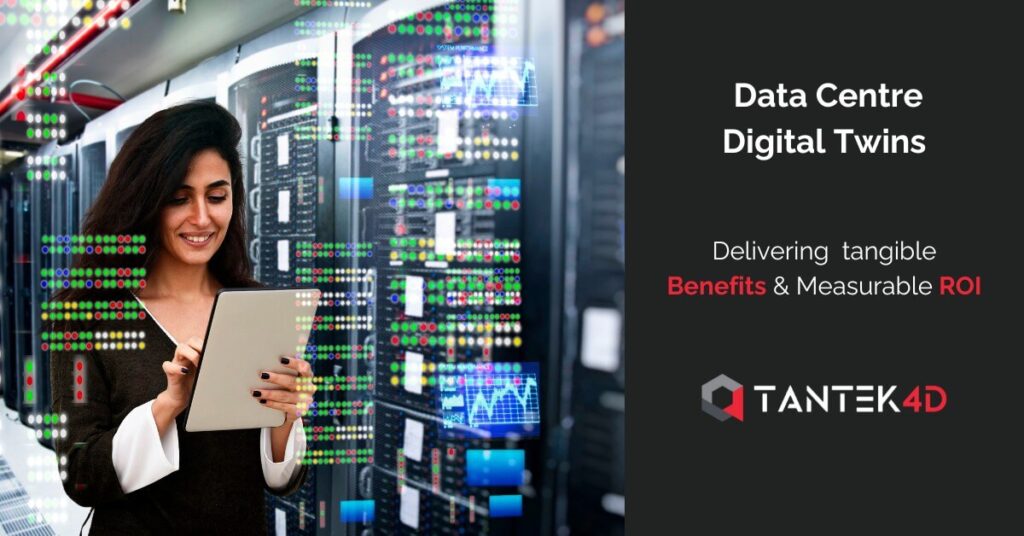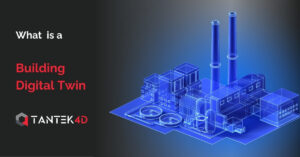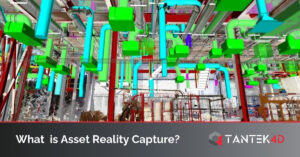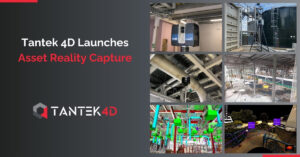The modern data centre is a complex environment with demanding customers, rapidly changing technologies, ever-present threats, and pressures to maintain maximum uptime, optimise profitability, and improve sustainability. Digital twin technologies reduce the complexity while delivering tangible benefits and measurable returns on investment.
The efficient utilisation of space, as well as power, cooling, and cabling considerations, are just some of the areas where digital twin solutions can add value to the management and operation of your data centre. Site security, environmental monitoring (temperature, humidity, etc), and rack layout design are other specific focus areas for data centres that can be enhanced with a digital twin.
But what is a data centre facility digital twin? Let’s go back to fundamentals before looking at the ways digital twins add value and deliver a return on investment.
What Is a Data Centre Facility Digital Twin?
A digital twin of a data centre facility is a digital representation of the building and all its equipment and components. It is created using the latest scanning technologies, so the digital representation is not only 3D, but it is also an accurate as-built representation.
A digital twin can also include sensor technologies that provide real-time updates on the facility, and it can be integrated with data centre infrastructure management (DCIM) tools. This extends the monitoring, planning, and interactive capabilities of a data centre digital twin beyond the infrastructure of the building and its components to also include the racks, network equipment, and servers contained within.
The Data in a Data Centre Digital Twin
The information and data points that can be included in a data centre digital twin include:
- Infrastructure information – the precise position of walls, pipes, cable infrastructure (including hidden cable infrastructure), structural supports, etc, as well as information on facility assets/equipment including HVAC units, CCTV, access control equipment, etc. The digital representation of the facility can not only include geospatial information on assets/equipment, but also information on the make, model, and operational notes.
- Assets – accurate, real-time information on all assets in the data centre, including servers, storage equipment, and networking equipment. Digital twins can also include highly detailed information on rack location, cabinet name, and rack unit position of every asset, as well as make, model, owner, and serial number information.
- Environmental information – including temperature, humidity, airflow, and pressure.
The ROI of Data Centre Digital Twins
There are a number of ways that digital twin technologies deliver benefits and tangible ROI for data centre facilities.
Project Efficiency
Whether planning a new data centre and optimising the rack layout and cooling system using computational fluid dynamics (CFD) modelling, or planning modernisation, improvement, or extension works, digital twins are highly valuable.
Let’s look at planning the cooling of a new data centre facility. CFD can be used to plan the cooling system in the facility, but this work is often conducted using construction drawings rather than as-built data. The constructed building and its features are likely to deviate from the construction drawings, with those deviations potentially impacting cooling efficiencies and the accuracy of CFD models.
A digital twin allows you to conduct CFD modelling using as-built data to verify, correct, and/or optimise cooling in the facility. This can deliver potentially substantial savings over the long term given the high costs of keeping data centres at an optimal operating temperature.
Improved Collaboration and the Elimination of Double Work
Information in data centres is often siloed. For example, a project team might need data, so they will commission a survey. However, that information may not be distributed properly across the organisation so when an engineering team needs similar data, they commission another survey. A single, complete, and accurate digital representation of your data centre facility solves these challenges by improving collaboration, information sharing, and communication.
Improved Uptime and a Reduction in Unplanned Downtime
A digital twin can be used to anticipate and predict issues so they can be dealt with proactively. This not only improves overall uptime but also reduces incidents of unplanned downtime. Unplanned downtime has immediate financial and resource costs, but there can also be negative impacts on your organisation’s reputation that can have longer-term consequences. A solution that reduces unplanned downtime will deliver a return on investment.
One way the digital twins can reduce unplanned downtime is by reducing (or even eliminating) human error. Human error is the cause of between 70 and 80 percent of data centre outages with the cost of each outage potentially running into millions. A digital twin of your data centre facility can provide technicians and operators with precise asset and component locations. Wayfinding functionality can also be used to not only show technicians the precise location of an asset or component, but to also direct them to that location.
Improved Efficiency and Sustainability
Reducing energy use is a key priority for data centres from a cost point of view as well as to make operations more sustainable. A digital twin of your facility will allow you to monitor energy use and identify areas for improvement. For example, areas where there is overcooling or where cooling is not efficient.
Remote Monitoring and Management Capabilities
A digital representation of your data centre facility reduces the requirement for individuals and teams to be on-site. This includes individuals required for day-to-day management of the facility as well as teams working on specific projects. Planning an upgrade, services installation, or building extension, for example, won’t require the same level of boots-on-the-ground as a lot of the assessments, measurement taking, and planning work can be done in the digital space.
Capacity Planning
How well can your data centre meet future demands? This has always been a crucial question for data centres, but the recent growth of AI has brought it into even sharper focus given the significantly higher levels of power that AI technologies require. Digital twins enable you to test and plan different capacity scenarios.
Lowering Operating Costs
Digital twins help to lower operating costs in a number of ways, including optimising energy as mentioned above. Digital twin technologies also improve project delivery and decision-making, while helping to extend the usable life of equipment, reducing capital expenditure.
Data Centre Digital Twins – Can You Afford Not To?
A data centre digital twin will pay back your investment multiple times over based only on improvements the technology will make to your day-to-day operations. Factor in rack layout planning or capacity expansion projects where having accurate as-built facility data is essential, and the benefits of digital twins increase substantially. Investing in a data centre digital twin – the question is, can you afford not to?




